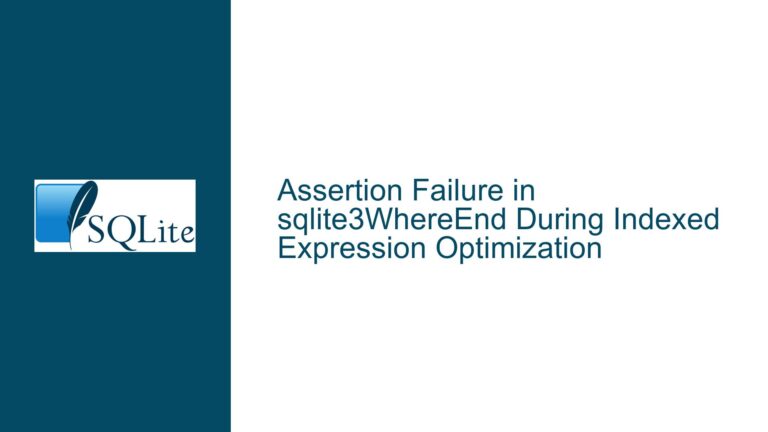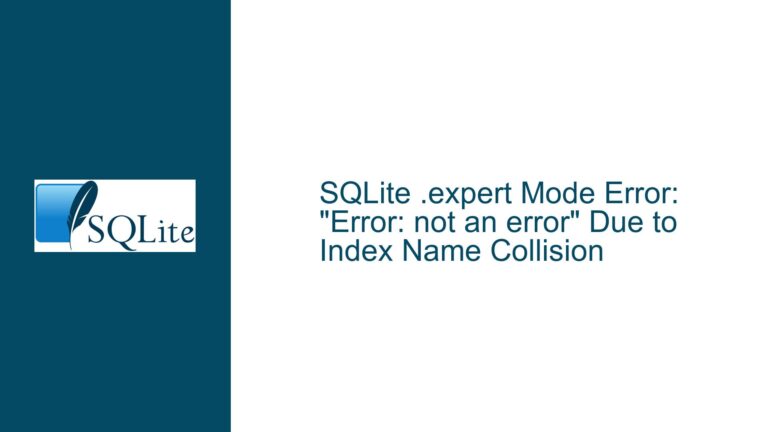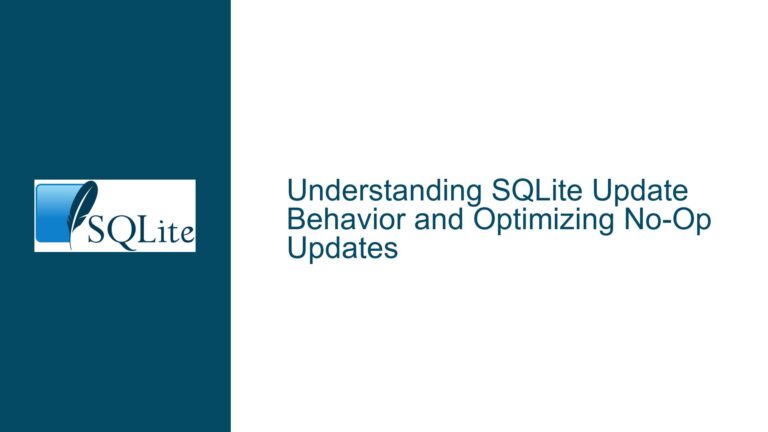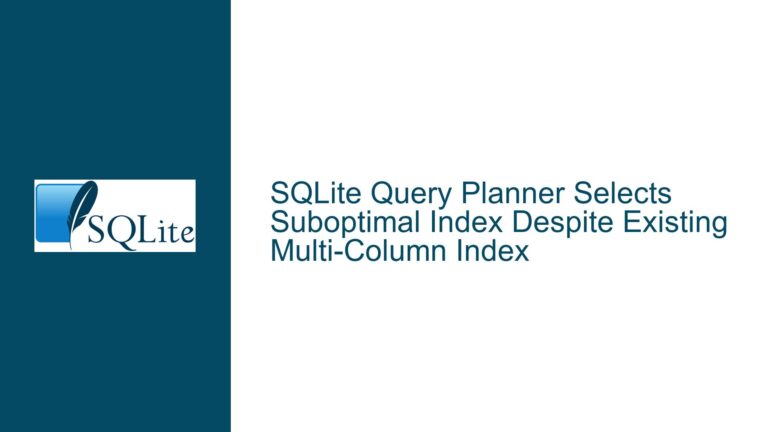Interpreting SQLite .selecttrace Output for Query Optimization
Understanding the Structure and Content of .selecttrace Files
The .selecttrace file in SQLite is a diagnostic tool that provides detailed insights into the query optimization process. This file is generated when the SQLite engine is configured to output trace information, typically for debugging or performance tuning purposes. The content of a .selecttrace file is a textual representation of the internal steps taken by the SQLite query optimizer, including the evaluation of different query plans, cost estimations, and the final selection of the most efficient execution strategy.
The example provided in the discussion illustrates a typical .selecttrace output. The file begins with a header indicating the start of a query optimization process, followed by a series of entries that describe the optimizer’s actions. Each entry corresponds to a specific step in the optimization process, such as the evaluation of a particular index or the calculation of the cost associated with a specific query plan. The entries are structured in a hierarchical manner, reflecting the nested nature of the query execution plan.
One of the key elements in the .selecttrace output is the ptr field, which points to the memory address of a specific data structure used by the optimizer. This pointer is crucial for understanding how the optimizer is interacting with the underlying data structures, such as tables and indexes. The nCol field indicates the number of columns in the table being processed, while the used field provides a bitmask that shows which columns are actually used in the query.
The .selecttrace output also includes detailed information about the cost estimation process. The cost field, for example, provides a numerical value that represents the estimated cost of executing a particular query plan. This cost is calculated based on factors such as the number of rows to be processed, the complexity of the query, and the availability of indexes. The optimizer uses this cost estimation to compare different query plans and select the one with the lowest cost.
In addition to the cost estimation, the .selecttrace output includes information about the query execution plan itself. This includes details about the tables and indexes involved in the query, as well as the specific operations that will be performed, such as table scans, index lookups, and joins. The output also includes information about the order in which these operations will be executed, which is critical for understanding the overall performance of the query.
The .selecttrace file is a powerful tool for diagnosing performance issues in SQLite queries. By carefully analyzing the content of this file, developers can gain a deep understanding of how the SQLite optimizer is processing their queries and identify potential bottlenecks or inefficiencies. However, interpreting the .selecttrace output requires a solid understanding of SQLite’s internal workings, including its query optimization algorithms and data structures.
Common Misinterpretations and Pitfalls in Analyzing .selecttrace Output
While the .selecttrace file provides a wealth of information, it is not always straightforward to interpret. One common pitfall is misinterpreting the ptr field. This field points to the memory address of a data structure, but without access to the source code or detailed documentation, it can be difficult to determine exactly what this data structure represents. In some cases, the ptr field may point to a table or index, while in other cases, it may point to a more complex data structure used internally by the optimizer.
Another common issue is misunderstanding the cost field. The cost value is an estimate, and it is based on a number of assumptions about the data and the query. If these assumptions are incorrect, the cost estimate may not accurately reflect the actual performance of the query. For example, if the optimizer assumes that a certain index is highly selective, but in reality, the index is not selective at all, the cost estimate may be too low, leading the optimizer to choose a suboptimal query plan.
The used field can also be a source of confusion. This field is a bitmask that indicates which columns are used in the query, but it does not provide any information about how these columns are used. For example, a column may be used in a WHERE clause, a JOIN condition, or a SELECT list, and the impact on performance can vary significantly depending on how the column is used. Without additional context, it can be difficult to determine the exact role of each column in the query.
The hierarchical structure of the .selecttrace output can also be challenging to navigate. The output is organized in a tree-like structure, with each level representing a different stage in the query optimization process. However, the relationships between different levels are not always clear, and it can be difficult to trace the flow of information from one level to the next. This can make it challenging to identify the root cause of a performance issue, especially if the issue is related to a complex query with multiple nested subqueries or joins.
Finally, it is important to note that the .selecttrace output is not static. The format and content of the output can change between different versions of SQLite, and even between different builds of the same version. This means that the interpretation of the .selecttrace output may need to be adjusted depending on the specific version of SQLite being used. Developers should always refer to the latest documentation and source code when analyzing .selecttrace output, and be prepared to adapt their analysis as needed.
Best Practices for Analyzing and Optimizing Queries Using .selecttrace Output
To effectively use the .selecttrace output for query optimization, developers should follow a systematic approach that includes both the analysis of the .selecttrace file and the implementation of changes based on that analysis. The first step is to generate the .selecttrace file for the query in question. This can be done by enabling the appropriate trace options in SQLite, either through the command-line interface or programmatically using the SQLite API.
Once the .selecttrace file has been generated, the next step is to carefully analyze its content. This involves identifying the key sections of the output, such as the cost estimation, the query execution plan, and the data structures used by the optimizer. Developers should pay particular attention to the cost field, as this provides a quantitative measure of the efficiency of the query plan. If the cost is high, it may indicate that the optimizer has chosen a suboptimal plan, and further investigation is needed.
One effective strategy for analyzing the .selecttrace output is to compare it with the actual execution of the query. This can be done by running the query with the EXPLAIN QUERY PLAN statement, which provides a high-level overview of the query execution plan. By comparing the .selecttrace output with the EXPLAIN QUERY PLAN output, developers can gain a better understanding of how the optimizer is interpreting the query and identify any discrepancies between the estimated and actual performance.
Another important aspect of analyzing the .selecttrace output is to consider the impact of indexes on query performance. The .selecttrace file provides detailed information about the indexes used by the optimizer, including their selectivity and the cost associated with using them. If the optimizer is not using an index that is expected to be beneficial, it may be necessary to reevaluate the index definition or consider adding additional indexes to improve performance.
In some cases, the .selecttrace output may reveal that the optimizer is making incorrect assumptions about the data. For example, if the optimizer assumes that a certain column has a high degree of selectivity, but in reality, the column contains many duplicate values, the cost estimate may be inaccurate. In such cases, it may be necessary to update the statistics used by the optimizer or provide additional hints to guide the optimizer in selecting a more efficient query plan.
Finally, developers should be aware that the .selecttrace output is just one tool in the query optimization process. While it provides valuable insights into the internal workings of the SQLite optimizer, it should be used in conjunction with other tools and techniques, such as profiling, benchmarking, and code review. By combining these approaches, developers can achieve a more comprehensive understanding of query performance and implement more effective optimizations.
In conclusion, the .selecttrace file is a powerful tool for diagnosing and optimizing SQLite queries. By carefully analyzing the content of this file and following a systematic approach to query optimization, developers can identify and address performance issues, leading to more efficient and reliable database applications. However, interpreting the .selecttrace output requires a deep understanding of SQLite’s internal workings, and developers should be prepared to invest the time and effort needed to master this tool.






